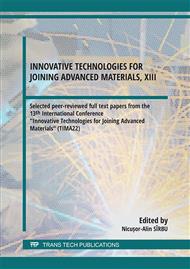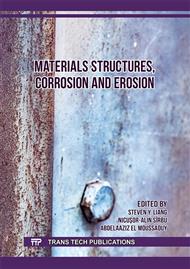[1]
I. Bordeașu, Monografia Laboratorului de cercetare a eroziunii prin cavitație al Universității Politehnica Timișoara 1960-2020, (Editura Politehnica, Timișoara 2020).
DOI: 10.24193/subbchem.2020.1.21
Google Scholar
[2]
I. Mitelea, T. Wolfgang, Știința Materialelor II, (Editura Politehnica, Timișoara 2007).
Google Scholar
[3]
F. Frant, I. Mitelea, I. Bordeaşu, C. Codrean, D. Mutaşcu, Effect of some heat treatments on cavitation erosion resistance of the EN AW - 6082 alloy, 28th International Conference on Metallurgy and Materials, Brno, Czech Republic, May 22nd - 24th , pp.663-667 (2019).
DOI: 10.37904/metal.2019.835
Google Scholar
[4]
Bordeasu, I., Popoviciu, M.O., Salcianu, L.C., Ghera, C., Micu, L.M., Badarau, R., Iosif, A., Pirvulescu, L.D., Podoleanu, C.E., 2017 A new concept for stainless steels ranking upon the resistance to cavitation erosion, International Conference on Applied Science IOP Conference Series-Materials Science and Engineering, vol. 163, 12002, (2017)
DOI: 10.1088/1757-899x/163/1/012002
Google Scholar
[5]
Istrate, I., Chera, C., Salcianu, L., Bordeasu, I., Ghiban, B., BĂZĂVAN, D.V., MICU, L.M., STROIȚĂ, D.C., Daniel OSTOIA- Heat Treatment Influence of Alloy 5083 on Cavitational Erosion Resistance, Magazine of Hydraulics, Pneumatics, Tribology, Ecology, Sensorics, Mechatronics, ISSN 1453 – 7303, Hidraulica (No. 3/2021) Pages 15-25
Google Scholar
[6]
Luca, A.N., Bordeașu, I., Ghiban, B., Ghera, C., Istrate, D., Stroiță, D.C., - Modification of the cavitation resistance by hardening heat treatment at 450°C followed by artificial aging at 180°C of the aluminum alloy typer 5083 compared to the state of cast semifinished product, Magazine of Hydraulics, Pneumatics, Tribology, Ecology, Sensorics, Mechatronics, ISSN 1453 – 7303 , Hidraulica No. 1 (2022), pp.39-45
DOI: 10.3390/met13061067
Google Scholar
[7]
Bordeașu, I., Ghera C., Istrate, I., Sălcianu, L., Ghiban, B., Băzăvan, D.V., Micu, L.M., Stroiță, D.C., Suta, A., Tomoiagă, I., Luca, A.N.,- Resistance and Behavior to Cavitation Erosion of Semi-Finished Aluminum Alloy 5083, Magazine of Hydraulics, Pneumatics, Tribology, Ecology, Sensorics, Mechatronics, ISSN 1453 – 7303, HIDRAULICA" No. 4 (2021), pp.17-24
Google Scholar
[8]
D.C. Stroita, A.S. Manea, A. Cernescu, Blade polymeric material study of a cross-flow water turbine runner, Materiale Plastice, Vol. 56 (2019), pp.366-369.
DOI: 10.37358/mp.19.2.5187
Google Scholar
[9]
D. Istrate, C. Ghera, L. Salcianu, I. Bordeasu, B. Ghiban, D.V. Bazavan, L. M. Micu, D.C. Stroita, D. Ostoia, Heat treatmente influence of alloy 5083 on cavitational erosion resistance, Magazine of Hydraulics, Pneumatics, Tribology, Ecology, Sensorics, Mechatronics, "HIDRAULICA", Vol. 3 (2021).
DOI: 10.3390/cryst12111538
Google Scholar
[10]
C.L. Salcianu, C. Ghera, I. Bordeașu, B. Ghiban, M.L. Micu, I. Dionisie, O.P. Odagiu, A. Luca, On the modification of the cavitation resistance of the aluminum alloy 2017 A, through the parameters of the heat treatment of aging, 10th International Conference of Applied Science, Banja Luka, (2022) , in curs de publicare
Google Scholar
[11]
*** Standard method of vibratory cavitation erosion test, ASTM, Standard G32, (2016)
Google Scholar
[12]
Information on https://www.camsa.ro/product-category/produse/componente/hidraulice/ pompe-hidraulice/pompe-cu-roti-dintate-si-corp-din-aluminiu/
Google Scholar
[13]
Information on https://alloy.ro/sudura-elice-de-barca-din-aluminiu
Google Scholar
[14]
Information on https://matmatch.com/learn/material/aircraft-aluminium-grades
Google Scholar



